Friday 1st June – Fleets Dam – A heavy mist sits on the tops of the houses and trees as dawn lightens the sky. It is much less dense by breakfast and practically gone by the time Dill the Dog and I get to the Fleets. A Wren is singing loudly from the trees over the River Dearne. The lake is surrounded by anglers with their poles blocking the path. There are the usual Great Crested Grebes on the water and a Grey Heron flying around croaking harshly. The sun is breaking through as we head off.
It is certain Midas never saw a hare
Or he would not have lusted after gold.
Anna Crowe
Saturday 2nd June – Silkstone Fall – Another misty start to the day. Drops condensing on the leaves pitter-patters down. Bird song is loud – Wrens, Robins, Blackbirds and Chaffinches. A Jay moves through the trees with a subdued and quiet muttering. Near the Scout camp, I stop and listen. Dill the Dog is peering off down the path. Suddenly something is moving down a small path joining this one. A Hare looms into sight and comes to about ten feet away. It suddenly sees Dill the Dog, who still has her back to it, and stops dead. It then notices me. There is a breathless pause and then the Hare turns and gallops away. Further down the woods, more Jays are in the trees but they are making their usual raucous noise. A Great Spotted Woodpecker is tapping on the top of a sheared-off Larch. A sudden jip call rings out – a Crossbill but I can see no sign of it.
Sunday 3rd June – Bretton Woods – We visit the woods after our shopping spree at Leeds Farmers’ Market. Strawberries are clearly coming into season and several stalls have dozens of boxes piled up. On the way back, above woods next to the Denby Dale Road near Calder Grove, a Common Buzzard is soaring. The woods are warm in the morning sunshine. Bird song is somewhat muted apart from a loud Chaffinch in the Ash trees by the track. The pool is silent; Yellow Flags are just going over. Froghoppers have been busy as the waterside grass is splattered with “cuckoo spit”. A large patch of umbellifer is growing near the reeds and flags – possibly Hemlock or maybe one of the Dropworts – I need to re-examine them.
Monday 4th June – Dove Trail, Worsbrough – Off down the old railway track of the disused Penistone-Wombwell line. Purple and pink bells of Comfrey dangle. Everywhere is damp and it is overcast. Hawthorns have finished flowering and now tiny haws are developing. Elderflowers are in full blossom. Blackberries are very varied, some flowers yet to open and on other brambles, the fruit is set. Chiffchaffs are singing; one from the top of an Alder, another from the very top of a tall Silver Birch. A Greenfinch wheezes his song and Wrens and Great Tits can also be heard. Red Campion stands brightly pink against the rich green undergrowth. The area of Worsbrough Dale at this point was called Goose Hulls. A branch of the Dearne and Dove canal, as well as the River Dove ran down the valley. A section of canal is still present in the park, but has disappeared elsewhere. A paper mill, Lewden Mill, stood around here. Beyond there are fishing ponds called Lewden Spring Fishery, although the spring was on the other side of the railway and road. The hamlet of Lewden is now just a few houses. A road, now called Station Road crosses the path and river, the latter via a bridge marked 1817 and called Lewden Bridge. House Martins twitter as they chase insects. Back along the trail and then off across the river. The path forks, one way heads along what once was Dark Lane, another, Powder Mill Lane passes a couple of ponds and then climbs up the hill towards what was once Worsbrough Dale Powder Mill, although there are no signs of it now. This mill made gunpowder and was the site of an explosion in 1907. I leave this path and cross the hill top which has been landscaped and planted with conifers and broadleaf trees. There are brick-built shafts accessing large clay drainage pipes which run under the ground across the hill. Sky Larks and Willow Warblers are in song and Swifts sweep overhead. Several Common Pheasants and Red-legged Partridge are flushed. The faint path swings round and joins Dark Lane. The path heads up towards Worsbrough Village in what was Worsbrough Park. Down the hill the road joins the main Sheffield Road. Park Lodge stands on the junction with the gate posts that would have formed the entrance to the park still standing either side of the lane. Just down the road is The Button Mill pub. It was called The Red Lion until a couple of years ago, as it had been in the 1850s. I am not sure about the names, although it is recorded a Michael Leach, Button maker of Worsbrough Bridge died age 59 in 1803.
Tuesday 5th June – Oxspring – A bridge crosses the River Don at the bottom of Bower Dell. The old road and bridge curve around beside the newer one. Opposite and up the hill towards the village was once a mill built by John Rolling in 1828. He died in 1831 and the mill passed to his son who ran it until 1856 when a devastating fire badly damaged it and destroyed 10,000 tons of grain. It was restored and used as a maltings by Cubley Brewery. It had other uses until the early 20th century when it was bought by William Gittus of Springvale Wagon Works who converted it into the four cottages that stand today. A path runs downstream at the foot of a steep bank, called Pickcliffe Rocher, which rises many feet above the river valley. A large pipeline runs parallel to the path for a considerable distance. Turning a slight kink in the path surprises a family of Wrens who scatter, ticking angrily. The river, which had meandered off across a meadow returns. It is running a bright brown colour. Orange Tip butterflies fly over beds of Stinging Nettles. Two ruined buildings are rotting away below the path. The path comes out onto Thurgoland Bank. A brown and white “painted” horse trots up to a gate to say hello. Unfortunately, I have no titbits for it. I head back to Oxspring along the road, not the best of ways as cars and vans speed past closely – the idea of slowing down and passing widely seems alien to them. Back at the old bridge a Chiffchaff is singing, a Moorhen crosses the river and a Dipper flies downstream.
Wednesday 6th June – Treeton – A village to the south-east of the city of Sheffield. Treeton is named in the Domesday Book as Trectone and Tretone and Kirkby’s Inquest, as Treton, Tretthon and Treeton. “Tre” was a Celtic name meaning houses or hamlet, “ton” was Saxon for a farm, so it would seem to be a hybrid name meaning house-farm. However, the Concise Oxford Dictionary of British Place-Names states the name probably means “a farm with stakes”, from the Old English. Treeton is possibly best known as being in Rotherwood, where Sir Walter Scott stated Robin of Lockesley (Robin Hood) made his camp. Pre-Conquest Treeton was part of the lands of Morcar, Earl of Northumbria 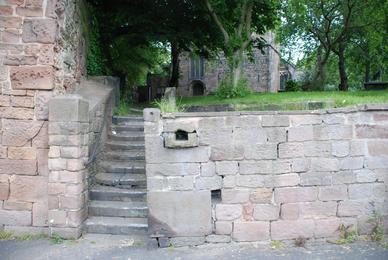 and farmed by Ulchil. However, as recorded above, like Ulley and the rest of the district the lands became the property of Robert de Morton, half-brother of William the Conqueror, younger brother of Bishop Odo of Bayeux. Robert gave it to Richard de Sourdeval, a minor Norman lord. Down Washfield Lane a short distance. This lane used to go right down to the River Don, passing over the Midland Railway line to Rotherham. Now across the valley is a huge expanse of earthen hillside where great earth-movers are erasing the last signs of Orgreave mines and coking plant – famous for the “Battle of Orgreave” where “Maggie’s Boot Boys”, the police, attacked hundreds of striking miners in the 1984 strike. Church Lane leads off this road. As the church gets nearer, so there are more older houses, built in a delightful pink sandstone that has an almost purplish tinge. A graveyard on the opposite side of the road from the church looks rather forlorn with long grass and fallen stone walls. The wall holding the churchyard has a wide stone chute emerging from it to drain the grounds.
and farmed by Ulchil. However, as recorded above, like Ulley and the rest of the district the lands became the property of Robert de Morton, half-brother of William the Conqueror, younger brother of Bishop Odo of Bayeux. Robert gave it to Richard de Sourdeval, a minor Norman lord. Down Washfield Lane a short distance. This lane used to go right down to the River Don, passing over the Midland Railway line to Rotherham. Now across the valley is a huge expanse of earthen hillside where great earth-movers are erasing the last signs of Orgreave mines and coking plant – famous for the “Battle of Orgreave” where “Maggie’s Boot Boys”, the police, attacked hundreds of striking miners in the 1984 strike. Church Lane leads off this road. As the church gets nearer, so there are more older houses, built in a delightful pink sandstone that has an almost purplish tinge. A graveyard on the opposite side of the road from the church looks rather forlorn with long grass and fallen stone walls. The wall holding the churchyard has a wide stone chute emerging from it to drain the grounds. 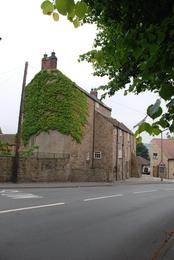 Rectory Cottage is a pretty building, but the Rectory looks fairly modern, although there is a large older house, Church House, behind it. The original small school stands on one side of the lane, built by subscription in 1830. Opposite is a far larger school built in 1887. On the corner is the School House. Church Lane ends at Station Road.
Rectory Cottage is a pretty building, but the Rectory looks fairly modern, although there is a large older house, Church House, behind it. The original small school stands on one side of the lane, built by subscription in 1830. Opposite is a far larger school built in 1887. On the corner is the School House. Church Lane ends at Station Road.
Just down the road is Jackson’s Farm. This site has been a farm with a blacksmith, wheelwright, joiner’s shop, bakers, tithe barn, builder’s shop and an undertakers, and one of the buildings is still a Chapel of Rest. Up the hill, Front Street leads off past the front of the church and Well Lane drops down the other side of the hill. Front Street has a useful little Post Office and the Reading Room, built in 1888 and still used for meetings. St Helen’s Church stands on a site of a church dating from 1175. There was a church in the area before as it is recorded in the Domesday Book. Arthur Mee’s, “The King’s England” describes the church as “charmingly odd with a long 14th century chancel,and a short 15th century aisle and a tower at the west end of the other aisle”. The church will have an open day at the weekend, but I will be unable to get there. A memorial to Boer War fallen stands near the road. It lists three names, all of whom died of “enteric fever” – typhoid. Manor Farm stands a short distance up Front Street from the church, then the road becomes Wood Lane. 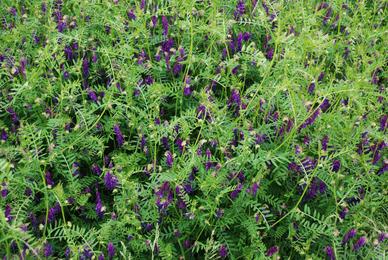 On one side is a row of well proportioned terraced houses built of local stone, but the next part of the row and the opposite side of the street are standard brick built late Victorian terraces. Pit Lane leads off, now into a new housing development. A short row of terraced houses are known as “The Big Six”, there being, indeed, six of them. New developments continue here, including an off-set roundabout in front of “The Crescent” and rather odd looking development of three, three storey buildings, each of maybe six homes in each, resembling, I suppose a crescent in Bath.
On one side is a row of well proportioned terraced houses built of local stone, but the next part of the row and the opposite side of the street are standard brick built late Victorian terraces. Pit Lane leads off, now into a new housing development. A short row of terraced houses are known as “The Big Six”, there being, indeed, six of them. New developments continue here, including an off-set roundabout in front of “The Crescent” and rather odd looking development of three, three storey buildings, each of maybe six homes in each, resembling, I suppose a crescent in Bath.
As the road leaves the village there is half a pit winding-wheel at the entrance to a path that leads down the hillside. Further up the road is Treeton Wood and down the path is Hail Mary Wood. This wood and nearby Falconer Wood are old woods which were coppiced until the 19th century for wood which was turned into the charcoal that fired the early iron works of Sheffield. Falconer Wood may well have been named after Robert de Faulkener, a 14th century Norman lord and landowner. Hail Mary Wood is recorded in 1768 as “Hell Mother Hill Wood”, in 1828 as “Hail Mother Hill Wood” and “Hail Mary Hill Wood” by 1855. The woods are cool and bird song rings out. A Green Woodpecker yaffles. A path leads down to a large lake that is a flooded sandstone quarry, doubtless the source of the stone that built Treeton. A concrete path leads around the edge of the water. The old stone wall can be seen below. Several Reed Warblers are singing in the reed beds, occasionally emerging to fly out and down into another part of the bed. A path heads back up towards Treeton. Either side are large tangled masses of Tufted Vetch creating a mound of green and rich purple. Whitethroats are singing from hedges across the hillside.
Thursday 7th June – Barugh and Higham – Two villages to the north of Barnsley. There is a milestone on the Barnsley-Holmfirth road heading into Barugh from Redbrook. It is made of a cast iron fascia on a stone pillar. The top records “Barnsley & Shepley – Lane Head Road – Baraugh”. The additional “a” in Barugh (pronounced “bark”) is odd as the traditional spelling has been either “Barugh” or even “Bargh”. Entering the village a road leads off to the left. It is lined by traditional Victorian terraces, then a couple of slightly grander houses before the modern developments that make up the bulk of the village now. Turning right and heading for the main road through the village, the houses are mainly post-First World War – Coronation Road, so probably mid-30s. Heading uphill the houses are again a mixture from the early Victorian to current developments. There are pair of interesting bungalows made of wooden lathes. At a junction that was far more important years ago stands The Engineer pub. Off down the hill is Pogwell Lane. The Pog Well was a short distance down this lane on a site now occupied by the cricket pitch. Royd Lane leads down the hill and under the M1 motorway. Crosswort is flowering profusely beside the path – tiny yellow flowers emerging from whorls of leaves up the stem. At the edge of Hugset Wood is Royd Bridge. The Higham Bottom Railway ran though here. The bridge is a small affair over a trickling brook. Many pieces of masonry are now lying in the bed of the stream. Dill the Dog takes some persuading to go down to get a drink as she is panting furiously. She manages to fall in and sits in the water looking mournful. Eventually she decides to move and get the drink of water she needs. Royd Lane continues but only as an earthen bridleway. Rich pink Dog Roses are in bloom either side of the path. The path drops down towards Barnbey Furnace. A path leads off alongside Silkstone Beck. The 1855 map seems to indicate that this path was a railway, with a junction to the old Silkstone Waggon Road further west. In places old walls that stood high above the stream still remain, but it is clear from the amount of dressed stone in the water that much has collapsed over the years. A Grey Wagtail flies downstream. The path emerges at Barnby Bridge, back on the Barnsley-Holmfirth road.
Friday 8th June – Robin Hoods Bay – It is the weekend of the annual Folk Festival. We head over the North York Moors in bright afternoon sunshine. Somehow the squat triangular military listening post at Fylingdales looks less threatening in the sun rather than the usual mist. However, as we reach Blue Bank the coast comes into view and there are large banks of sea mist or sea fret as it is known on the East Coast. When we reach the camp site at Fylingthorpe, the mist lays across the fields beyond, but the site is in glorious sunshine. After some confusion about where we are supposed to pitch, we set up the tent and settle back with a beer to await the rest of the “Barnsley Buglers”. They arrive in the early evening and, after a few more beers, we head off across the fields and down a beautiful wooded dell into Robin Hoods Bay. Careful manoeuvring enables us to get seats in the Bay Hotel where beer and songs flow. It is very dark as we climb the path up through the woods back to the camp site. Just after we have settled down in our tents there is a deep noise outside, getting closer. It is cows moving down the edge of the field next to our tent, munching the grass.
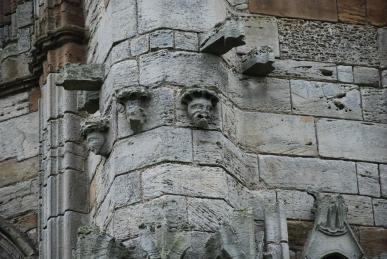
Saturday 9th June – Whitby – After one of our gargantuan fry-up breakfasts, Kay and I head into Whitby. We park at the Abbey and head down Caedmon’s Trod, one of the steep paths down into the town. The Old Town is crowded with tourists. I need a watch so purchase one for less than £5 from a market stall – it works, on and off! Then off to Fortune’s to get a supply of kippers. Back up the 199 Abbey steps, grateful for the seats provided. The view over the harbour is superb from here. We head back to the car through a 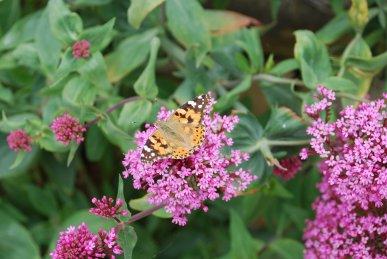 maze of paths and buildings, including the magnificent Youth Hostel. A wall round the back has Red Valerian growing out of it. The flowers host a good number of Painted Lady butterflies. Below on the slope of the hill are allotments, many having a fine selection of crops, others, sadly neglected. I pay a quick visit to the abbey. Swallows and House Martins sweep across the fish stew. The ruined walls of the abbey are silhouetted against a blue sky. There are various pieces of decorative stone on the walls, nearly all in a ruinous state. Just a few heads of saints remain high on on a corner tower. There would have been many such heads, now all gone. Broken empty niches will never house statues again. But the destroyed state of the building has its own beauty. It has an ageless tranquillity and state of grace that will endure. Far below, Whitby bustles and revels in commerce and materialism, but here only the birds and insects need be concerned with earthly matters.
maze of paths and buildings, including the magnificent Youth Hostel. A wall round the back has Red Valerian growing out of it. The flowers host a good number of Painted Lady butterflies. Below on the slope of the hill are allotments, many having a fine selection of crops, others, sadly neglected. I pay a quick visit to the abbey. Swallows and House Martins sweep across the fish stew. The ruined walls of the abbey are silhouetted against a blue sky. There are various pieces of decorative stone on the walls, nearly all in a ruinous state. Just a few heads of saints remain high on on a corner tower. There would have been many such heads, now all gone. Broken empty niches will never house statues again. But the destroyed state of the building has its own beauty. It has an ageless tranquillity and state of grace that will endure. Far below, Whitby bustles and revels in commerce and materialism, but here only the birds and insects need be concerned with earthly matters.
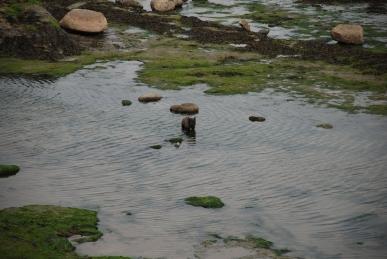
Robin Hoods Bay – Late afternoon sees us heading back down the track to the village. It is cool and so verdant in the dell. A fallen tree rots away surrounded by ferns and the new upstart saplings that will take its place. It is likely that no foot has trodden the fragile soils down near the hidden stream. It is inaccessible and who needs to disturb this beauty? We stop for fish and chips and then on to the Bay Hotel. We sit out on the balcony and watch the beach far below and the sea fret covering the headlands around the bay. The tide is far out leaving many rock pools. In the middle of one large pool stands a dog. It is a small and fairly scruffy canine and it just stands there, up to its stomach in the water. A small girl comes past and attempts to persuade it out, but no response. Next a man appears and again tries to get it to leave the pool. He moves around to the other side, crossing some slippery stones (certain members of our party are hoping for a ducking). As he gets close to the dog, it barks at him but makes no effort to move. The man decides he is not getting his shoes wet so gives up. A woman approaches and as people before calls to the dog, who studiously ignores her. Her dog plunges across the pool and pees in it – which seems a bit unreasonable! 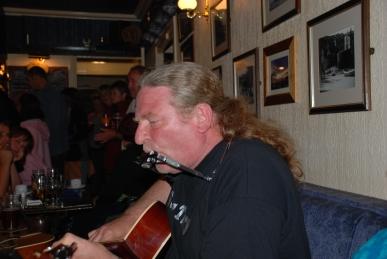 The woman removes her shoes, rolls up her trouser legs and walks across to the dog, who barks at her. She takes hold of his collar but he breaks free and trots over to another part of the pool. The woman returns to her shoes where she has left her dog’s lead. She enters the pool again and gets the dog onto the lead. It is none too impressed as it is dragged away across the beach. At the foot of the boat hard, the woman discusses with a friend their next step. They remove a name tube from the dog’s collar and open it, but do not seem to find anything useful. Eventually, they let the dog off the lead and, of course he trots straight back to his pool. He sits on a rock for a while before going into the water and standing there. About twenty minutes later, a man, who looks like a local fisherman in wellies, strides across the beach with a lead, puts it around the dog’s neck and set off back to the hard with the dog trotting along happily. We are all in aching from the amount of laughter this episode has engendered. It is getting cool, so we retreat into the bar for another evening of beer and songs.
The woman removes her shoes, rolls up her trouser legs and walks across to the dog, who barks at her. She takes hold of his collar but he breaks free and trots over to another part of the pool. The woman returns to her shoes where she has left her dog’s lead. She enters the pool again and gets the dog onto the lead. It is none too impressed as it is dragged away across the beach. At the foot of the boat hard, the woman discusses with a friend their next step. They remove a name tube from the dog’s collar and open it, but do not seem to find anything useful. Eventually, they let the dog off the lead and, of course he trots straight back to his pool. He sits on a rock for a while before going into the water and standing there. About twenty minutes later, a man, who looks like a local fisherman in wellies, strides across the beach with a lead, puts it around the dog’s neck and set off back to the hard with the dog trotting along happily. We are all in aching from the amount of laughter this episode has engendered. It is getting cool, so we retreat into the bar for another evening of beer and songs.
Tuesday 12th June – Fleets Dam – It is raining as I push through the sodden grasses and plants hanging over the path, weighed down by water. Inevitably, my legs are soaked by the time I reach the lake. A Blackcap keeps singing despite the weather. Not caring in the slightest about the rain are two broad-backed Carp that are thrashing in the reeds beside the bank as they mate. Back by the weir a Grey Wagtail bobs along the edge of the water seeking food in the flotsam.
Wednesday 13th June – Hollingbury Woods, Brighton – The woods are so different to those I remember from my childhood. It is hardly surprising as very few of the trees are over 20 years  old. The giants of my youth were massacred by the great storm of 1987. Rotting trunks still lay quietly decomposing amongst the upstarts that grabbed their opportunity when the century old woods crashed down. The allotments are still on both sides of the little valley of Roedale, still tended as well as ever; the only noticeable difference being the number of poly-tunnels now present. The traditional paths that led through the woods have often shifted; the old “cave” in the chalk under a great Beech’s roots has completely disappeared; the road down to the allotments is now a narrow path; steps now rise up where a steep, worn bank was trod as we headed up to school. Blackcaps and Robins are in song. A young rabbit by the path sees no urgency in loping gently away as Dill the Dog approaches. Up on the park, there are more rabbits which are equally disdainful of her. An underground reservoir is surrounded by a tall fence, which results in the banks being untouched by mowers or feet. Thus they are a dazzling display of flowers – Common Spotted Orchids, Ox-eye Daisies, Birds-foot Trefoils, Docks, Buttercups and Greater Knapweeds. Looking back down the hill towards the sea, there are billowing white clouds of sea-mist over the city (it still seems strange to call my old town a city!)
old. The giants of my youth were massacred by the great storm of 1987. Rotting trunks still lay quietly decomposing amongst the upstarts that grabbed their opportunity when the century old woods crashed down. The allotments are still on both sides of the little valley of Roedale, still tended as well as ever; the only noticeable difference being the number of poly-tunnels now present. The traditional paths that led through the woods have often shifted; the old “cave” in the chalk under a great Beech’s roots has completely disappeared; the road down to the allotments is now a narrow path; steps now rise up where a steep, worn bank was trod as we headed up to school. Blackcaps and Robins are in song. A young rabbit by the path sees no urgency in loping gently away as Dill the Dog approaches. Up on the park, there are more rabbits which are equally disdainful of her. An underground reservoir is surrounded by a tall fence, which results in the banks being untouched by mowers or feet. Thus they are a dazzling display of flowers – Common Spotted Orchids, Ox-eye Daisies, Birds-foot Trefoils, Docks, Buttercups and Greater Knapweeds. Looking back down the hill towards the sea, there are billowing white clouds of sea-mist over the city (it still seems strange to call my old town a city!)
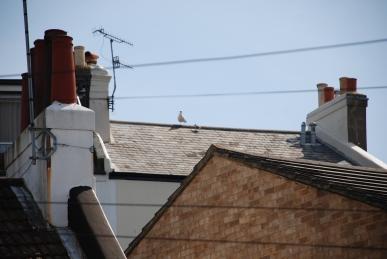
Brighton – From the window of Kay’s boys flat we can see roofs in all directions. On one is a young gawky bundle of grey-brown fluff. A Herring Gull chick has tumbled from its nest on a high chimney stack. It climbs the slates, slipping every now and again. A parent lands on the roof ridge and watches its little offspring. Another parent is feeding a sibling that has sensibly stayed in the nest. It is clear the errant chick cannot get back up into the nest. At last sight, it has moved down near the guttering. Whether the parents will feed it until it fledges is an unknown.
Woodingdean to Falmer – I drop Kay off at Sussex University for a funeral service for her former boss. I drive over to Woodingdean, a huge, mainly post-war housing estate. A row of shops is mainly services – several estate agents – but there is a traditional butchers shop where I purchase a pork pie. Driving back the road crosses the South Downs. Here the Downs are spread between the steep scarp slope over Plumpton and Ditchling and roll in sweeping valley to the sea cliffs between Brighton and Newhaven. The gentle valleys of green grass and grain crops contain white sheep and black and white cows. I have seen many magnificent landscapes in Britain – with more yet to see I trust – but the South Downs are part of me, fused into my soul so I cannot look upon them without feeling emotional about their beauty and familiarity. I know the paths, I know the woods, I know the views. I will never tire of them and wonder if I will ever walk and stand and look at them again.
Stanmer – Back in 1999, Stanmer House had been closed and looked like it may fall into total disrepair. It was built in 1727 and was the ancestral home of the Pelham family and the Earls of Chichester. Owned by the Council, it was used for functions up until the early 1990s, but no money was spent on the fabric of the building and it was becoming dangerous. It is pleasing that over recent years the building has been restored and is now looking magnificent again. The park is full of fine trees in full leaf, every shade of green seems to caress the eye which is then enchanted by a scattering of the rich purple-red of Copper Beeches. 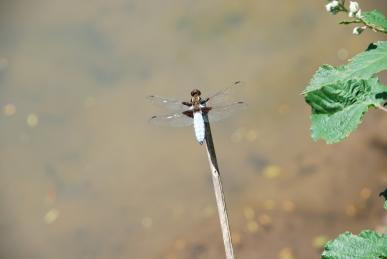 A small building under repair stands next to the church. It houses a well, 252 feet deep, that was dug in the 16th century, an eleven foot diameter donkey-wheel which was powered by donkey until 1870 and then by a man until 1900. The building itself was erected in 1838. Beside the building is the uprooted stump of a large Beech. The churchyard contains many graves, the earliest appears to be from 1707. One notable one is of Edward Payne who died of sun-stroke in the Harvest Field on 22nd July 1868 aged 61.
A small building under repair stands next to the church. It houses a well, 252 feet deep, that was dug in the 16th century, an eleven foot diameter donkey-wheel which was powered by donkey until 1870 and then by a man until 1900. The building itself was erected in 1838. Beside the building is the uprooted stump of a large Beech. The churchyard contains many graves, the earliest appears to be from 1707. One notable one is of Edward Payne who died of sun-stroke in the Harvest Field on 22nd July 1868 aged 61.
The pond is a murky brown colour. A Moorhen family seems to consist of a single near adult sized youngster and several tiny balls of black fluff just a few days old. A good number of damselflies, Banded Agrions, are like electric blue needles on the bramble leaves on the edge of the pool. Several much larger dragonflies, members of the family of darters, Libellulidae, are chasing around. A couple land on twigs and display their large powder blue bodies and the brown base to their wings that gives their names – Libellula quadrimaculata (quadrimaculata meaning four spotted), called the Four-spotted Chaser. A pair of Collared Doves descends to the water’s edge to drink but are seen off by one of the Moorhens. A Grey Wagtail bobs on the opposite edge. A young woman approaches and rather embarrassedly asks if I have a spare bag – for the dog – which I have. It is good that people are now accustomed to cleaning up after their dogs. The village consists of a farm and two rows of knapped flint-faced cottages. I doubt they are still occupied by the estate workers for whom they were built. Gardens have traditional flowers, such as Canterbury Bells. The pond at the end of the village is, rather less traditionally, full of goldfish.
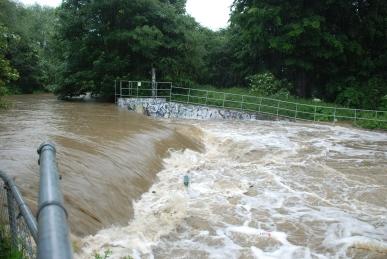
Friday 15th June – Fleets Dam – It has been raining all night and continues to pour down this morning. I head for the Smithies Lane entrance to the Fleets. From the far side I can see the River Dearne has burst its banks and water is pouring into the lake. I walk round to the breach, having to wade through ankle deep water 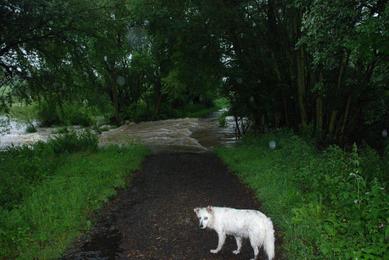 to get there. The brown water is a torrent. Off to the Asda car park and down to the Old Mill Lane weir. The structure has disappeared under a huge mass of water that is thundering downstream. Water is pouring out of the woods opposite in a continuous curtain over the concrete wall. I head up to the Fleets. A Chiffchaff is still singing despite the conditions. Bedraggled Grey Herons stand with their heads slumped between their shoulders. A lone tern patrols the lake. The outflow pipe from the lake is flowing in reverse with water pouring in from the river. The fields opposite are all under water. A horse stands by a huge pond looking at the water creeping up his field. The river breach is wide, thousands of gallons must be pouring into the lake every minute. Back by the bridge I note the water level indicator is almost completely submerged.
to get there. The brown water is a torrent. Off to the Asda car park and down to the Old Mill Lane weir. The structure has disappeared under a huge mass of water that is thundering downstream. Water is pouring out of the woods opposite in a continuous curtain over the concrete wall. I head up to the Fleets. A Chiffchaff is still singing despite the conditions. Bedraggled Grey Herons stand with their heads slumped between their shoulders. A lone tern patrols the lake. The outflow pipe from the lake is flowing in reverse with water pouring in from the river. The fields opposite are all under water. A horse stands by a huge pond looking at the water creeping up his field. The river breach is wide, thousands of gallons must be pouring into the lake every minute. Back by the bridge I note the water level indicator is almost completely submerged.
Old Mill Lane – By early evening the rain has stopped but the river has risen higher.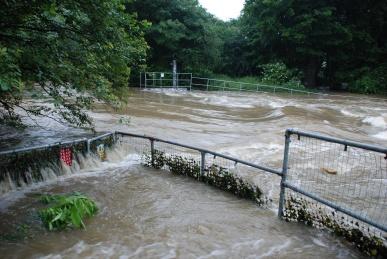 There is now no indication of the weir as the water pours both downstream and out across the woodland to the east. Water is lapping around the car park of the Carphone Warehouse. A lad tells me that horses had been trapped in the fields by the rising water and were rescued earlier in the afternoon. The path to the Fleets is under water. Reports tell how Darfield, Darton, Worsbrough, Grange Lane and Wombwell have all experienced serious flooding. Young people have been rescued from flood water in Sheffield. Residents of many years standing are saying they have never seen flooding like this before. By late evening it is raining again.
There is now no indication of the weir as the water pours both downstream and out across the woodland to the east. Water is lapping around the car park of the Carphone Warehouse. A lad tells me that horses had been trapped in the fields by the rising water and were rescued earlier in the afternoon. The path to the Fleets is under water. Reports tell how Darfield, Darton, Worsbrough, Grange Lane and Wombwell have all experienced serious flooding. Young people have been rescued from flood water in Sheffield. Residents of many years standing are saying they have never seen flooding like this before. By late evening it is raining again.
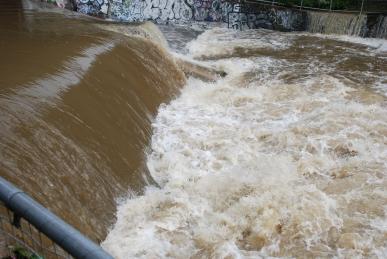
Saturday 16th June – The Fleets – The water level in the River Dearne has dropped by probably four feet overnight. Water is now dropping over the weir again and the channel walls are visible. The path to the Fleets is clear of water but has some signs that it was under water yesterday. The plants and grasses are beginning to grow erect again after being flattened by the torrent. The Fleets are now draining rather than filling. Damage is extensive. Most of the wooden fishing platforms on the eastern side have been destroyed, some are on the path. Logs and tree trunks have been thrown around the path. One of the wind-driven water aerators has drifted over towards the side of the lake.  The path is in a bad shape with holes gouged into it throughout its length. However, it is especially bad where the water burst through from the river yesterday. Large holes in the ground, areas of grass rolled back and all the plants flattened. A Common Tern is diving regularly after fish. At first there are no Grey Herons but one flies in and lands on a fishing platform that is floating in the middle of the water. It looks like the old iron landing stage has been destroyed.
The path is in a bad shape with holes gouged into it throughout its length. However, it is especially bad where the water burst through from the river yesterday. Large holes in the ground, areas of grass rolled back and all the plants flattened. A Common Tern is diving regularly after fish. At first there are no Grey Herons but one flies in and lands on a fishing platform that is floating in the middle of the water. It looks like the old iron landing stage has been destroyed.
Monday 18th June – The Fleets – Despite more rain last night, the water levels in river and lake continue to fall. The height to which the lake had risen is indicated by the reappearance of the landing stage, it was simply submerged. Plants and grasses along the path that was flooded have bounced back and look as though nothing had happened. The river is again within the confines of the weir wall, but there is considerable damage to trees that were growing beneath the concrete walls a little downstream as large lumps of brickwork and masonry have crashed into them.
Barnsley Canal, Old Mill – The water level in this short stretch of canal is high. The bases of a number of new fishing platforms (why they have to have these unsightly things is rather beyond me!) are floating in the water, the rest are submerged. Shoals of tiny fish fry dart about in the water. A Chiffchaff is singing a rather poor version of its song. Mallard ducklings are now almost adult sized. Tiny Moorhen chicks are on one of the fishing platforms floating on the far bank. The Mallard ducklings approach but are seen off by the adult Moorhen. Good numbers of brilliant blue Banded Agrion damsel flies are hovering over and shooting across the path between various resting spots. Down in the Dearne Valley Country Park there is evidence of the flooding with large areas of flattened plants – including much Japanese Knotweed, no loss there – and damaged paths. The footbridge over the river shows signs that it has been submerged, it is now over eight feet above the water. Back up to the canal and the large Goldfish, seen last May, is lurking just under the surface.
Tuesday 19th June – Barnsley Canal – Down Willowbank where there are signs of flowing water. Honeysuckle is in blossom. The water level is high in the canal. Dog Roses are coming out in various shades of pink. A Sedge Warbler and Whitethroat are singing near the bridge. Everything is growing fast and high. Docks and Stinging Nettles are both shoulder high. On the rough pasture below the tow-path the only sign of flooding is a line of dead bits of reed. Jays, a Chiffchaff, Green Woodpecker and Reed Warbler are all in song. The white rump of a Bullfinch disappears along the canal hedgerow. I have not noticed before that the wall around Tinkers Pond is inset with iron wheels, about 18 inches in diameter and almost certainly from coal trucks used in the old Willow Bank pit.
Bentcliff Hill – There is a sharp bend in the road from Cawthorne to Hoylandswaine at Haddon Farmhouse. The area opposite was known as Hadden Green, which would indicate a change in the spelling of the farmhouse name. Just before the bend a path leads up Bentcliff Hill. The recent rain has washed all the mud off the path leaving a cobble of rough stones. In a couple of places old wooden fence posts have been laid into the cobbles. This path was formally known as Bentcliff Hill Lane. Towards the top of the hill the path has a coating of slurry and dark brown puddles the run-off from a huge pile of manure on the hill top. Dill the Dog has to wade through one of the puddles! Old stone walls line the path now. Over to the wall to the south-east is a field of brown and white cows and beyond the farm, which from old maps would be Banks Hall. The modern OS map indicates the field as Bentcliff Hall. This seems odd as there is no sign of a building here nor on the 1855 map, thus I suspect this is a spelling mistake, Hall for Hill. From the hill top, there are splendid views over Cawthorne and across to Barnsley, with the hospital on the sky line.
Wednesday 20th June – Wombwell Ings – Thunderstorms rumbled through the night. The first arrived at about 21:30 with torrential rain. Another extremely prolonged roll awoke me in the middle of the night. This morning is very bright and clean smelling. Broomhill Flash and Wombwell Ings are both greatly extended by flooding across the fields. There are numerous small brown slugs on the old road and a few snails with chocolate and yellow shells. A lime green and black-striped caterpillar of the Burnet Moth is also crossing the tarmac.
Adwick-Le-Street – A village to the north of Doncaster. The street referred to in the name is the great Roman road of Ermine Street which passes nearby. The church of St Laurence was recorded in the 12th  century, but from its alignment probably lies on the site of an older building, possibly the temple of a Romano-British settlement. The village was a small rural settlement until the beginning of the 20th century when the sinking of Brodworth Main Colliery in 1905 brought in an influx of miners and their families. The population had risen to nearly 12,000 by 1921. The village is notable for the lack of buildings more than a century old, indeed around the church there seems to be few over forty years old. The church itself is of a pale limestone. There is a stump cross outside the porch. By it is a grave of Mary Newton but she is not here as the stone says she died “at Hull” in 1894 and was interred in “Hull W. Cemetry No. 1290”. It then states “Absent:Present 2nd Cor. 5c 8v” (which reads – We are confident, I say, and willing rather to be absent from the body, and to be present with the Lord). Another grave records the death of Walter Woodcock, “killed on the railway May 17th 1896 aged 25 years”. To the east runs the railway – the Doncaster-Leeds part of the East Coast mainline. Nearby, the Telephone Exchange is now a domestic dwelling. Beside the railway stands a classic building of Victorian Gothic. A Blackcap is singing in a tree, oblivious of the traffic. I am attempting to photograph it, but the blast of the horn from a passing freight train is too much and it flies off. Back along towards the village centre there is a growth of particularly pink Greater Bindweed. The church bells sound 10 o’clock. On the way back down the A1 there is a three lorry pile-up causing a huge tail-back down the motorway.
century, but from its alignment probably lies on the site of an older building, possibly the temple of a Romano-British settlement. The village was a small rural settlement until the beginning of the 20th century when the sinking of Brodworth Main Colliery in 1905 brought in an influx of miners and their families. The population had risen to nearly 12,000 by 1921. The village is notable for the lack of buildings more than a century old, indeed around the church there seems to be few over forty years old. The church itself is of a pale limestone. There is a stump cross outside the porch. By it is a grave of Mary Newton but she is not here as the stone says she died “at Hull” in 1894 and was interred in “Hull W. Cemetry No. 1290”. It then states “Absent:Present 2nd Cor. 5c 8v” (which reads – We are confident, I say, and willing rather to be absent from the body, and to be present with the Lord). Another grave records the death of Walter Woodcock, “killed on the railway May 17th 1896 aged 25 years”. To the east runs the railway – the Doncaster-Leeds part of the East Coast mainline. Nearby, the Telephone Exchange is now a domestic dwelling. Beside the railway stands a classic building of Victorian Gothic. A Blackcap is singing in a tree, oblivious of the traffic. I am attempting to photograph it, but the blast of the horn from a passing freight train is too much and it flies off. Back along towards the village centre there is a growth of particularly pink Greater Bindweed. The church bells sound 10 o’clock. On the way back down the A1 there is a three lorry pile-up causing a huge tail-back down the motorway.
Saturday 23rd June – Gunthwaite – We stop by the Hall as Kay has not seen the great barn. The farm dogs are locked in pens. One Border Collie is barking frantically and running up the wooden wall of the pen and somersaulting in its excitement. Dill the Dog cannot hear them and fails to notice anything going on!
Hazlehead Hall Farm – The farm has some new pigs in the field by the farm shop. Their website says they are bringing in Tamworths, but these look like young Large Blacks to me. They trot up to see us as we look over the gate, which they use for a  satisfying scratch.
satisfying scratch.
Cleckheaton – An entertaining night in Cleckie with the Newcastle folk duo, Acoustica, putting on a show in the local church hall with our friends Dave and his daughter Zöe supporting. We nip off to The Marsh, a nice traditional pub owned by the Old Mill Brewery, for a few pints whilst the performers are setting up. Then back for an evening of traditional and modern songs.
Monday 25th June – Fleets Dam – It has been raining all night and the steady downpour continues this morning. The River Dearne has risen rapidly again, although not to the extent that caused the extensive floods last week. The measurement pole that was submerged during the floods is showing at least a metre and half above the water level. The track to the Fleets has large puddles all along it and I soon tire of wet feet and beat a retreat. Dill the Dog looks fairly relieved by this decision.
Mid-afternoon and the rain has not ceased. It ranges from steady downpour to heavy downpour. A milky-coffee coloured torrent is roaring over the weir. The wall opposite still stands maybe four or five foot above the water – last week the river was close to the top of this wall. I walk along the path to the Fleets, my trouser legs are dripping by the time I reach the open track around the lake. The level of the Fleets is high. Along where the breach first occurred last week, the water is getting close to the path. The fields opposite are lakes again. Even the Great Crested Grebe, a bird which is so well adapted to the water, seems annoyed by the continuous rain, rising in the water and giving its wings a shake.
Barnsley Canal – Old Mill – Water is roaring down from the retail park high above the canal. The fishing platforms, or at least those that remain after the last flood, are under water again. Near the end of this section of canal a large number of tiny froglets are hopping across the path and off into the wooded slope that leads down to the Dearne. Down on the footbridge, the river is rushing through the channel made by the huge pillars that once held the canal from Wakefield as it crossed the valley to join the Barnsley section. Back on the canal, the young Mallard are floating together in the middle of the water, their heads tucked round on their backs.

Tuesday 26th June – Dearne Valley – It finally stopped raining early yesterday evening. Reports come in of extensive flooding in Sheffield – Lady Bridge, a main route into the city is overwhelmed as the River Don burst its banks. Two people have been swept away by the water. Ulley Reservoir is reported to be in a dangerous state with cracks in the dam wall. Many have been moved from their homes down the valley. The M1 motorway is closed in both directions around Meadowhall. Water is several feet higher than yesterday at the weir by Old Mill 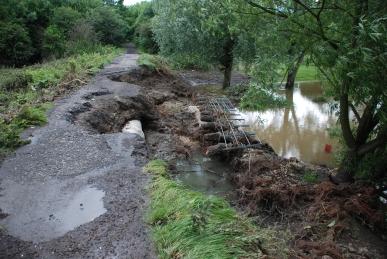 Lane, but it is clear it has dropped a fair bit from overnight. Water is again draining off the woodland by the Carphone Warehouse and fields are flooded. Mud up trees shows the water must have been several feet deep on the path to the Fleets. The willow carr is deeper than I have ever seen it. A Kingfisher flashes off downstream. Down the valley the damage around the Dearne Valley Country Park is extensive. At the bottom of the green grassland a picnic bench stands in deep water. The River Dearne is rushing under the footbridge that has replaced the old railway bridge. The fishing lake is full and the path at the top end has been badly eroded exposing a large sewage pipe. The steel fencing lies at the bottom of a small gully where the bank as collapsed. The council had put down white hardcore to repair damage to paths caused by last week’s flooding
Lane, but it is clear it has dropped a fair bit from overnight. Water is again draining off the woodland by the Carphone Warehouse and fields are flooded. Mud up trees shows the water must have been several feet deep on the path to the Fleets. The willow carr is deeper than I have ever seen it. A Kingfisher flashes off downstream. Down the valley the damage around the Dearne Valley Country Park is extensive. At the bottom of the green grassland a picnic bench stands in deep water. The River Dearne is rushing under the footbridge that has replaced the old railway bridge. The fishing lake is full and the path at the top end has been badly eroded exposing a large sewage pipe. The steel fencing lies at the bottom of a small gully where the bank as collapsed. The council had put down white hardcore to repair damage to paths caused by last week’s flooding 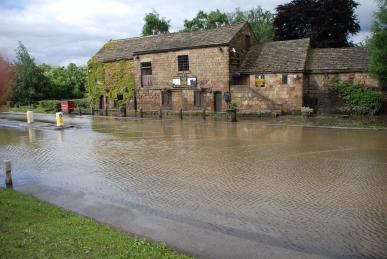 – it is scattered and in places rather neatly piled up in mounds. A footbridge over the river is only a couple inches above the river level. A huge tree trunk has been wedged between the trunks of a large Willow. A Cormorant flies over high in the sky, probably spoilt for choice as to which expanse of water to land on. Blackbirds and Song Thrushes are singing loudly in defiance of the water. Grange Lane is closed. The road through Lundwood towards Cudworth is at a standstill. A road in the housing estate is under water. I head down beside the Monk Bretton Priory and across to Grange Lane. The road is flooded by the Mill of the Black Monk pub, which looks like it is flooded again. The River Dearne has spread right across the playing fields.
– it is scattered and in places rather neatly piled up in mounds. A footbridge over the river is only a couple inches above the river level. A huge tree trunk has been wedged between the trunks of a large Willow. A Cormorant flies over high in the sky, probably spoilt for choice as to which expanse of water to land on. Blackbirds and Song Thrushes are singing loudly in defiance of the water. Grange Lane is closed. The road through Lundwood towards Cudworth is at a standstill. A road in the housing estate is under water. I head down beside the Monk Bretton Priory and across to Grange Lane. The road is flooded by the Mill of the Black Monk pub, which looks like it is flooded again. The River Dearne has spread right across the playing fields.
Wednesday 27th June – Willowbank – Twenty-four hours without rain is a relief, but more is forecast for today. Overhead there are welcome patches of blue sky, but rather too much grey cloud. A Greenfinch wheezes his song nearby and a Dunnock is singing loudly across the hillside. Over the valley the fields are looking very muddy and lots of laying water is still on them. A Chiffchaff calls without any urgency. A Sedge Warbler scratches his song down near the Loop, which seems to be at a normal water level. Likewise the canal, although it is a lot of water considering the time of year. Up the hill beyond the canal footbridge is an area of scrub. The plant growth is very vibrant – Mayweed, Wild Mignonette, Good King Henry, Hedge Mustard, Tufted Vetch, Hogweed, Smooth Sow-Thistle, Common Poppy, Ox-eye Daisy, Comfrey and emerging Rosebay Willowherb – all in a stretch of maybe fifteen yards.
Wakefield – The River Calder rushes under Wakefield Bridge. The Chantry Chapel of St Mary stands quiet above the brown waters that swirl around the stone arches below. On the Kirkgate side of the bridge is Navigation Yard, where there are a couple of old buildings amongst the modern industrial units. One has a blue plaque recording that until 1860 the building housed the Boardroom of the Aire and Calder Navigation, a waterways company founded in 1699 and formally Britain’s richest. It now houses a training agency. The building is constructed in well-dressed stone. Next door is a similar building in a red brick. By the railway bridge is a modern store with the Royal Coat of Arms set into its wall, clearly much older than the building itself. The other side of the bridge contains only a few older buildings, a three storey shop of 1906 with a nicely shaped portico. The pub, The Grey Horse, looks early 20th century. Round the corner is the Wakefield Arms, bricked up and derelict. Kirkgate Station is round another corner. It is a very depressing sight. The first station was built here by the Manchester and Leeds Railway in 1840. The present building dates from 1857, seventeen years before the main Westgate Station was built. Once a roof covered the whole station but this has been demolished. The walls are covered in filthy decaying paint. All the waiting rooms and ticket office are locked and barred. It seems appropriate that as soon as I step onto the platform a train cancellation is announced, causing groans of anger from waiting passengers. Some distance away a sleek intercity train glides past on the mainline. Back outside in a mid 20th century housing estate the Primrose Tavern, in Tavern Street is now a kebab shop. There are a few older terraces but overall the place seems utterly soulless.
Thursday 28th June – Wombwell Ings – The ings are flooded up to the bank that encircles the whole site. The tops of Hawthorn bushes rise out of the water. The water has clearly been over the top of the bank indicating the river level must have been some ten feet or more higher than now. Up near the gate, which is on a raised piece of land, there is a line of flotsam that shows how far the water must have risen. Eight Mute Swans glide across what is usually rough meadow. A few Tufted Duck are on the water, but there are no other wildfowl in sight. The flood drain is shut – at first I think this strange as it would help drain the meadow, but then on second thoughts it is obvious that this water is better here than adding to the extensive flood problems downstream in Doncaster. The Poplars along the edge of Broomhill Park rustle continuously in the wind. One has a large branch broken off which is laying along another branch. I imagine it will dislodge 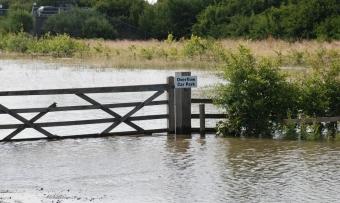 in a high wind and would not like to be underneath when it comes down.
in a high wind and would not like to be underneath when it comes down.
Old Moor – I call into the RSPB Reserve at Old Moor to see if they want my collection of old birding magazines (they do which is far better than just putting them in the paper recycling bin). A sign indicates “Overflow car park”, the overflow now being water as the place is flooded.
Mexborough – Many routes in and out of the town are still closed by flooding. Mexborough was a market town with a castle built in the 11th century by Roger Busli. The truncated motte, encased by a wide ditch, defends an eastern bailey and a small northern mound, which is possibly a barbican. It overlooks the Strafford Sands, an important crossing of the River Don. The town grew around a pottery industry, quarrying and eventually coal mining. Brian Blessed (actor), Ted Hughes (Poet Laureate) and Donald Watson (Founder of the Vegan Society) are all connected with the town. I head up Dolcliffe Hill. An old stone built school on the hillside is surrounded by new-build. The road leads into streets of Victorian terraces. Many of the houses have been named, a few singly but mainly in pairs or even more – Hurst House 1903, Fern Villas 1902 etc. Dolcliffe Street School was a decent sized affair, now housing a business centre. The recreation ground, clear on early 20th century maps is still being used for cricket and football. From the higher ground the extensive flooding can be seen with many acres under water.
Friday 29th June – Dearne Valley Country Park – The level of the River Dearne has dropped considerably and it is running much clearer now. Debris is hanging in the overhanging tree branches many feet above the river level. Some damage has been done to the near vertical banks, new roots are exposed. Blackbirds and Song Thrushes sing from the slope leading up to pit head of Barnsley Main. A rabbit is visible where the trees have been cut to form a grass bank down the hillside. A Grey Wagtail flies along the path.
Netherwood Country Park – The flooding of the River Dove has removed most of one side of the bridge in Netherwood Road and dumped in the road. The ducks and geese in the large pond do not seem to have been affected by the floods and swim over as I approach and then retreat noisily on seeing Dill the Dog. Debris in the riverside trees shows the water level must have been 10 to 12 feet higher than now. The river is still much higher than normal. In the park, House Martins are chasing overhead, twittering excitedly. Some paths have been gouged out by flood water leaving scars up to 2 feet deep.
 and farmed by Ulchil. However, as recorded above, like
and farmed by Ulchil. However, as recorded above, like  Rectory Cottage is a pretty building, but the Rectory looks fairly modern, although there is a large older house, Church House, behind it. The original small school stands on one side of the lane, built by subscription in 1830. Opposite is a far larger school built in 1887. On the corner is the School House. Church Lane ends at Station Road.
Rectory Cottage is a pretty building, but the Rectory looks fairly modern, although there is a large older house, Church House, behind it. The original small school stands on one side of the lane, built by subscription in 1830. Opposite is a far larger school built in 1887. On the corner is the School House. Church Lane ends at Station Road. On one side is a row of well proportioned terraced houses built of local stone, but the next part of the row and the opposite side of the street are standard brick built late Victorian terraces. Pit Lane leads off, now into a new housing development. A short row of terraced houses are known as “The Big Six”, there being, indeed, six of them. New developments continue here, including an off-set roundabout in front of “The Crescent” and rather odd looking development of three, three storey buildings, each of maybe six homes in each, resembling, I suppose a crescent in Bath.
On one side is a row of well proportioned terraced houses built of local stone, but the next part of the row and the opposite side of the street are standard brick built late Victorian terraces. Pit Lane leads off, now into a new housing development. A short row of terraced houses are known as “The Big Six”, there being, indeed, six of them. New developments continue here, including an off-set roundabout in front of “The Crescent” and rather odd looking development of three, three storey buildings, each of maybe six homes in each, resembling, I suppose a crescent in Bath.
 maze of paths and buildings, including the magnificent Youth Hostel. A wall round the back has Red Valerian growing out of it. The flowers host a good number of Painted Lady butterflies. Below on the slope of the hill are allotments, many having a fine selection of crops, others, sadly neglected. I pay a quick visit to the abbey. Swallows and House Martins sweep across the fish stew. The ruined walls of the abbey are silhouetted against a blue sky. There are various pieces of decorative stone on the walls, nearly all in a ruinous state. Just a few heads of saints remain high on on a corner tower. There would have been many such heads, now all gone. Broken empty niches will never house statues again. But the destroyed state of the building has its own beauty. It has an ageless tranquillity and state of grace that will endure. Far below, Whitby bustles and revels in commerce and materialism, but here only the birds and insects need be concerned with earthly matters.
maze of paths and buildings, including the magnificent Youth Hostel. A wall round the back has Red Valerian growing out of it. The flowers host a good number of Painted Lady butterflies. Below on the slope of the hill are allotments, many having a fine selection of crops, others, sadly neglected. I pay a quick visit to the abbey. Swallows and House Martins sweep across the fish stew. The ruined walls of the abbey are silhouetted against a blue sky. There are various pieces of decorative stone on the walls, nearly all in a ruinous state. Just a few heads of saints remain high on on a corner tower. There would have been many such heads, now all gone. Broken empty niches will never house statues again. But the destroyed state of the building has its own beauty. It has an ageless tranquillity and state of grace that will endure. Far below, Whitby bustles and revels in commerce and materialism, but here only the birds and insects need be concerned with earthly matters.
 The woman removes her shoes, rolls up her trouser legs and walks across to the dog, who barks at her. She takes hold of his collar but he breaks free and trots over to another part of the pool. The woman returns to her shoes where she has left her dog’s lead. She enters the pool again and gets the dog onto the lead. It is none too impressed as it is dragged away across the beach. At the foot of the boat hard, the woman discusses with a friend their next step. They remove a name tube from the dog’s collar and open it, but do not seem to find anything useful. Eventually, they let the dog off the lead and, of course he trots straight back to his pool. He sits on a rock for a while before going into the water and standing there. About twenty minutes later, a man, who looks like a local fisherman in wellies, strides across the beach with a lead, puts it around the dog’s neck and set off back to the hard with the dog trotting along happily. We are all in aching from the amount of laughter this episode has engendered. It is getting cool, so we retreat into the bar for another evening of beer and songs.
The woman removes her shoes, rolls up her trouser legs and walks across to the dog, who barks at her. She takes hold of his collar but he breaks free and trots over to another part of the pool. The woman returns to her shoes where she has left her dog’s lead. She enters the pool again and gets the dog onto the lead. It is none too impressed as it is dragged away across the beach. At the foot of the boat hard, the woman discusses with a friend their next step. They remove a name tube from the dog’s collar and open it, but do not seem to find anything useful. Eventually, they let the dog off the lead and, of course he trots straight back to his pool. He sits on a rock for a while before going into the water and standing there. About twenty minutes later, a man, who looks like a local fisherman in wellies, strides across the beach with a lead, puts it around the dog’s neck and set off back to the hard with the dog trotting along happily. We are all in aching from the amount of laughter this episode has engendered. It is getting cool, so we retreat into the bar for another evening of beer and songs. old. The giants of my youth were massacred by the great storm of 1987. Rotting trunks still lay quietly decomposing amongst the upstarts that grabbed their opportunity when the century old woods crashed down. The allotments are still on both sides of the little valley of Roedale, still tended as well as ever; the only noticeable difference being the number of poly-tunnels now present. The traditional paths that led through the woods have often shifted; the old “cave” in the chalk under a great Beech’s roots has completely disappeared; the road down to the allotments is now a narrow path; steps now rise up where a steep, worn bank was trod as we headed up to school. Blackcaps and Robins are in song. A young rabbit by the path sees no urgency in loping gently away as Dill the Dog approaches. Up on the park, there are more rabbits which are equally disdainful of her. An underground reservoir is surrounded by a tall fence, which results in the banks being untouched by mowers or feet. Thus they are a dazzling display of flowers – Common Spotted Orchids, Ox-eye Daisies, Birds-foot Trefoils, Docks, Buttercups and Greater Knapweeds. Looking back down the hill towards the sea, there are billowing white clouds of sea-mist over the city (it still seems strange to call my old town a city!)
old. The giants of my youth were massacred by the great storm of 1987. Rotting trunks still lay quietly decomposing amongst the upstarts that grabbed their opportunity when the century old woods crashed down. The allotments are still on both sides of the little valley of Roedale, still tended as well as ever; the only noticeable difference being the number of poly-tunnels now present. The traditional paths that led through the woods have often shifted; the old “cave” in the chalk under a great Beech’s roots has completely disappeared; the road down to the allotments is now a narrow path; steps now rise up where a steep, worn bank was trod as we headed up to school. Blackcaps and Robins are in song. A young rabbit by the path sees no urgency in loping gently away as Dill the Dog approaches. Up on the park, there are more rabbits which are equally disdainful of her. An underground reservoir is surrounded by a tall fence, which results in the banks being untouched by mowers or feet. Thus they are a dazzling display of flowers – Common Spotted Orchids, Ox-eye Daisies, Birds-foot Trefoils, Docks, Buttercups and Greater Knapweeds. Looking back down the hill towards the sea, there are billowing white clouds of sea-mist over the city (it still seems strange to call my old town a city!)
 A small building under repair stands next to the church. It houses a well, 252 feet deep, that was dug in the 16th century, an eleven foot diameter donkey-wheel which was powered by donkey until 1870 and then by a man until 1900. The building itself was erected in 1838. Beside the building is the uprooted stump of a large Beech. The churchyard contains many graves, the earliest appears to be from 1707. One notable one is of Edward Payne who died of sun-stroke in the Harvest Field on 22nd July 1868 aged 61.
A small building under repair stands next to the church. It houses a well, 252 feet deep, that was dug in the 16th century, an eleven foot diameter donkey-wheel which was powered by donkey until 1870 and then by a man until 1900. The building itself was erected in 1838. Beside the building is the uprooted stump of a large Beech. The churchyard contains many graves, the earliest appears to be from 1707. One notable one is of Edward Payne who died of sun-stroke in the Harvest Field on 22nd July 1868 aged 61.
 to get there. The brown water is a torrent. Off to the Asda car park and down to the Old Mill Lane weir. The structure has disappeared under a huge mass of water that is thundering downstream. Water is pouring out of the woods opposite in a continuous curtain over the concrete wall. I head up to the Fleets. A Chiffchaff is still singing despite the conditions. Bedraggled Grey Herons stand with their heads slumped between their shoulders. A lone tern patrols the lake. The outflow pipe from the lake is flowing in reverse with water pouring in from the river. The fields opposite are all under water. A horse stands by a huge pond looking at the water creeping up his field. The river breach is wide, thousands of gallons must be pouring into the lake every minute. Back by the bridge I note the water level indicator is almost completely submerged.
to get there. The brown water is a torrent. Off to the Asda car park and down to the Old Mill Lane weir. The structure has disappeared under a huge mass of water that is thundering downstream. Water is pouring out of the woods opposite in a continuous curtain over the concrete wall. I head up to the Fleets. A Chiffchaff is still singing despite the conditions. Bedraggled Grey Herons stand with their heads slumped between their shoulders. A lone tern patrols the lake. The outflow pipe from the lake is flowing in reverse with water pouring in from the river. The fields opposite are all under water. A horse stands by a huge pond looking at the water creeping up his field. The river breach is wide, thousands of gallons must be pouring into the lake every minute. Back by the bridge I note the water level indicator is almost completely submerged. There is now no indication of the weir as the water pours both downstream and out across the woodland to the east. Water is lapping around the car park of the Carphone Warehouse. A lad tells me that horses had been trapped in the fields by the rising water and were rescued earlier in the afternoon. The path to the Fleets is under water. Reports tell how Darfield, Darton, Worsbrough, Grange Lane and Wombwell have all experienced serious flooding. Young people have been rescued from flood water in Sheffield. Residents of many years standing are saying they have never seen flooding like this before. By late evening it is raining again.
There is now no indication of the weir as the water pours both downstream and out across the woodland to the east. Water is lapping around the car park of the Carphone Warehouse. A lad tells me that horses had been trapped in the fields by the rising water and were rescued earlier in the afternoon. The path to the Fleets is under water. Reports tell how Darfield, Darton, Worsbrough, Grange Lane and Wombwell have all experienced serious flooding. Young people have been rescued from flood water in Sheffield. Residents of many years standing are saying they have never seen flooding like this before. By late evening it is raining again.
 The path is in a bad shape with holes gouged into it throughout its length. However, it is especially bad where the water burst through from the river yesterday. Large holes in the ground, areas of grass rolled back and all the plants flattened. A Common Tern is diving regularly after fish. At first there are no Grey Herons but one flies in and lands on a fishing platform that is floating in the middle of the water. It looks like the old iron landing stage has been destroyed.
The path is in a bad shape with holes gouged into it throughout its length. However, it is especially bad where the water burst through from the river yesterday. Large holes in the ground, areas of grass rolled back and all the plants flattened. A Common Tern is diving regularly after fish. At first there are no Grey Herons but one flies in and lands on a fishing platform that is floating in the middle of the water. It looks like the old iron landing stage has been destroyed. century, but from its alignment probably lies on the site of an older building, possibly the temple of a Romano-British settlement. The village was a small rural settlement until the beginning of the 20th century when the sinking of Brodworth Main Colliery in 1905 brought in an influx of miners and their families. The population had risen to nearly 12,000 by 1921. The village is notable for the lack of buildings more than a century old, indeed around the church there seems to be few over forty years old. The church itself is of a pale limestone. There is a stump cross outside the porch. By it is a grave of Mary Newton but she is not here as the stone says she died “at Hull” in 1894 and was interred in “Hull W. Cemetry No. 1290”. It then states “Absent:Present 2nd Cor. 5c 8v” (which reads – We are confident, I say, and willing rather to be absent from the body, and to be present with the Lord). Another grave records the death of Walter Woodcock, “killed on the railway May 17th 1896 aged 25 years”. To the east runs the railway – the Doncaster-Leeds part of the East Coast mainline. Nearby, the Telephone Exchange is now a domestic dwelling. Beside the railway stands a classic building of Victorian Gothic. A Blackcap is singing in a tree, oblivious of the traffic. I am attempting to photograph it, but the blast of the horn from a passing freight train is too much and it flies off. Back along towards the village centre there is a growth of particularly pink Greater Bindweed. The church bells sound 10 o’clock. On the way back down the A1 there is a three lorry pile-up causing a huge tail-back down the motorway.
century, but from its alignment probably lies on the site of an older building, possibly the temple of a Romano-British settlement. The village was a small rural settlement until the beginning of the 20th century when the sinking of Brodworth Main Colliery in 1905 brought in an influx of miners and their families. The population had risen to nearly 12,000 by 1921. The village is notable for the lack of buildings more than a century old, indeed around the church there seems to be few over forty years old. The church itself is of a pale limestone. There is a stump cross outside the porch. By it is a grave of Mary Newton but she is not here as the stone says she died “at Hull” in 1894 and was interred in “Hull W. Cemetry No. 1290”. It then states “Absent:Present 2nd Cor. 5c 8v” (which reads – We are confident, I say, and willing rather to be absent from the body, and to be present with the Lord). Another grave records the death of Walter Woodcock, “killed on the railway May 17th 1896 aged 25 years”. To the east runs the railway – the Doncaster-Leeds part of the East Coast mainline. Nearby, the Telephone Exchange is now a domestic dwelling. Beside the railway stands a classic building of Victorian Gothic. A Blackcap is singing in a tree, oblivious of the traffic. I am attempting to photograph it, but the blast of the horn from a passing freight train is too much and it flies off. Back along towards the village centre there is a growth of particularly pink Greater Bindweed. The church bells sound 10 o’clock. On the way back down the A1 there is a three lorry pile-up causing a huge tail-back down the motorway. satisfying scratch.
satisfying scratch.
 Lane, but it is clear it has dropped a fair bit from overnight. Water is again draining off the woodland by the Carphone Warehouse and fields are flooded. Mud up trees shows the water must have been several feet deep on the path to the Fleets. The willow carr is deeper than I have ever seen it. A Kingfisher flashes off downstream. Down the valley the damage around the Dearne Valley Country Park is extensive. At the bottom of the green grassland a picnic bench stands in deep water. The River Dearne is rushing under the footbridge that has replaced the old railway bridge. The fishing lake is full and the path at the top end has been badly eroded exposing a large sewage pipe. The steel fencing lies at the bottom of a small gully where the bank as collapsed. The council had put down white hardcore to repair damage to paths caused by last week’s flooding
Lane, but it is clear it has dropped a fair bit from overnight. Water is again draining off the woodland by the Carphone Warehouse and fields are flooded. Mud up trees shows the water must have been several feet deep on the path to the Fleets. The willow carr is deeper than I have ever seen it. A Kingfisher flashes off downstream. Down the valley the damage around the Dearne Valley Country Park is extensive. At the bottom of the green grassland a picnic bench stands in deep water. The River Dearne is rushing under the footbridge that has replaced the old railway bridge. The fishing lake is full and the path at the top end has been badly eroded exposing a large sewage pipe. The steel fencing lies at the bottom of a small gully where the bank as collapsed. The council had put down white hardcore to repair damage to paths caused by last week’s flooding  – it is scattered and in places rather neatly piled up in mounds. A footbridge over the river is only a couple inches above the river level. A huge tree trunk has been wedged between the trunks of a large Willow. A Cormorant flies over high in the sky, probably spoilt for choice as to which expanse of water to land on. Blackbirds and Song Thrushes are singing loudly in defiance of the water. Grange Lane is closed. The road through Lundwood towards Cudworth is at a standstill. A road in the housing estate is under water. I head down beside the Monk Bretton Priory and across to Grange Lane. The road is flooded by the Mill of the Black Monk pub, which looks like it is flooded again. The River Dearne has spread right across the playing fields.
– it is scattered and in places rather neatly piled up in mounds. A footbridge over the river is only a couple inches above the river level. A huge tree trunk has been wedged between the trunks of a large Willow. A Cormorant flies over high in the sky, probably spoilt for choice as to which expanse of water to land on. Blackbirds and Song Thrushes are singing loudly in defiance of the water. Grange Lane is closed. The road through Lundwood towards Cudworth is at a standstill. A road in the housing estate is under water. I head down beside the Monk Bretton Priory and across to Grange Lane. The road is flooded by the Mill of the Black Monk pub, which looks like it is flooded again. The River Dearne has spread right across the playing fields. in a high wind and would not like to be underneath when it comes down.
in a high wind and would not like to be underneath when it comes down.